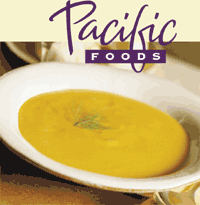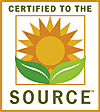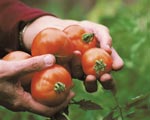SUSTAINABILITY profile
by Alicia Lundquist Guy
This article was originally published in January 2004

Pacific Foods: A Northwest promise of freshness
(January 2004) — Come the cold days of January, many of us look forward to the fresh start of a new year, leaving the surfeit of holiday dining behind us. The menu turns to a simple pot of warming soup, accompanied by a hearty loaf of rustic bread and greens or fresh fruit.
When a lack of foresight leaves me with a scant half an hour before dinner and no homemade soup stock in sight, an almost made-from-scratch soup is much better than no soup at all. It’s at these times that I’m thankful for convenience foods such as Pacific Foods Organic Free-Range Chicken Broth.
Pacific Foods has made homemade soups more likely to appear on my dinner table with their line of prepared soup stocks — vegetable, chicken, beef and mushroom. With these shelf-stable containers of soup bases on hand, chopped fresh veggies and leftover grains can be easily incorporated into a healthful meal in the blink of an eye. I’ve always avoided prepackaged soup stocks because of the traditional mystery list of unpronounceable ingredients. But, like me, Pacific Foods wants to know exactly what goes into their products.

Through its internal program called Certified to the Source™, Pacific Foods carefully tracks the history and origin of all ingredients used in creating its products. Every new supplier must complete a detailed ingredient/disclosure statement, and in-house or laboratory testing may be utilized in addition to plant inspections. Ron Martell, vice president of marketing, says, “We are taking and qualifying everything we are doing in an organized manner. We can tell any one of our consumers where our soybeans were grown, who it was that grew them, and what was done to them.”
Pacific Foods has been locally owned and operated since 1987 in Tualatin, Oregon, just outside of Portland. It has a stated goal to become an “environmentally neutral company” and is striving for that goal on many fronts. With 150 employees and two processing plants, Pacific Foods is no small operation and is constantly challenged to walk its talk.
In 2001, it started Pacific Environmental Group, the sole purpose of which is to address waste management issues at the processing plants. It has implemented a facility-wide recycling program and now recycles 40 tons of cardboard per month. A large proportion of Pacific Foods product sales can be attributed to organic soymilk. Production of the soymilk creates more than 20 tons of okara, a high protein organic by-product of soybeans. The okara is then dried and converted into reusable animal feed sold to organic dairy farmers in Oregon, who incorporate it into the cows’ organic diet.

In an effort to have even tighter control over the quality of ingredients, Pacific Foods founded Biogroup of Oregon in 2000. It acquired 40 acres of farmland that was fully transitioned to organic production in the fall of 2003. Greenhouses on the farm have been used to grow the tomatoes for the tomato paste used in many of their products. Keri Erving, Product Marketing Manager at Pacific Foods adds, “This year, we will be growing the squash that goes into our butternut squash soup. Because we are using the land ourselves, we have more control over the quality.”
Many consider the paper-composite packaging (or, as the industry refers to it, aseptic packaging) used to package shelf-stable products such as those of Pacific Foods to be an environmental bonus as well. According to an article in the Nov/Dec 2002 issue of E: the Environmental Magazine, an aseptic package of soymilk is 96 percent beverage to 4 percent packaging by weight, less than glass or aluminum.
The packaging is filled using less energy than traditional commercial canning and, because aseptic packages are shelf- stable, no energy is used on refrigeration. The packaging arrives to food processing plants in large rolls; 1.5 million single-serve containers can fit on one truck, as opposed to 14 truckloads for single serve glass containers.
Although still a very small proportion of the waste stream, aseptic packaging, consisting of 70 percent paper, 24 percent polyethylene and 6 percent aluminum, can now be recycled in many municipalities, including areas serviced by Seattle Public Utilities and by Waste Management.
A wide variety of shelf-stable Pacific products can be found in the aisles of PCC. In addition to the various flavors of soymilk, Pacific also offers other beverages including rice, oat, multi-grain, almond and even hazelnut milk. Also available are prepackaged gravies and finished creamy soups such as butternut squash, French onion, creamy broccoli, and roasted red pepper and tomato.
Pacific Foods can meet the needs of every chef, whether a health-conscious eater with only a microwave, a bowl and a spoon, or a gourmet chef of five-course meals wanting to simplify party preparations in the coming year.
